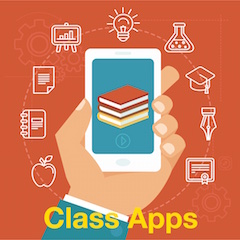Helping Students Hone Key Communication Skills
A MiddleWeb Blog

Students Who Can Text But Struggle to Talk
I worry about the number of students I encounter who struggle with sustained and/or face-to-face conversations. Many seem uncomfortable with pairing and sharing, giving short presentations, and a variety of other classroom tasks that require them to speak and make eye contact with others.
Paul Barnwell, an education writer for The Atlantic, said it this way:
It might sound like a funny question, but we need to ask ourselves: Is there any 21st-century skill more important than being able to sustain confident, coherent conversation? …Kids spend hours each day engaging with ideas and one another through screens—but rarely do they have an opportunity to truly hone their interpersonal communication skills.
When students apply for colleges and jobs, they won’t conduct interviews through their smartphones. When they negotiate pay raises and discuss projects with employers, they should exude a thoughtful presence and demonstrate the ability to think on their feet (or at least without Google). When they face significant life decisions, they must be able to think things through and converse with their partners.
If the majority of their conversations are based on fragments pin-balled back and forth through a screen, how will they develop the ability to truly communicate in person?
Personally, I absolutely love talking to people, whether it’s my students, colleagues, family, friends, or new people I meet in line in the grocery store. But I also admit that I love the time I save by texting and messaging when it comes to managing the minutiae of life — like trying to figure out whose turn it is to take the kids to soccer practice.
Accomplishing the same thing via a phone conversation easily takes ten times longer. Not to mention the number of people who have their phones on silent and/or don’t answer, so I end up having to text them anyway.
But messaging and texting skills are not sufficient when it comes to meaningful conversations, social interaction, and the nuances that accompany each. Albert Mehrabian, a UCLA professor, found that 58 percent of communication is through body language, 35 percent through vocal tone, pitch, and emphasis, and a mere seven percent through content of the message (Mehrabian, 2008).
In other words, a student whose social skill set is limited to the use of their phone has roughly seven percent of what they need to be an effective communicator.
Fostering Communication Skills
If we are not careful, we can fall into the trap of growing annoyed and contemptuous when students struggle with interpersonal communication. I have heard teachers who blame society’s ever-increasing reliance on technology. Others are convinced that students are to blame for spending endless hours on social media and/or video games. However, there are plenty of students who struggle with social communication that are NOT inundated by technology.
As educators, we will be much more effective if we try to bridge the communication gap the same way we approach other underdeveloped abilities.
A student’s ability to attentively listen to others, formulate and share a thoughtful response, engage in extended conversation, make eye contact…each of these skills results from experience and an environment that fosters interpersonal communication. So instead of playing the ‘blame game,’ educators should work to develop a student-oriented approach that encourages kids to prepare for, engage in, and reflect on a variety of interactions with each other and adults (Burden & Byrd, 2016).
Some skill-building activities might include:
- Virtual or face-to-face visits with ‘interesting adults,’ or professionals/experts in a variety of fields. These visits should require students to prepare, ask, and respond to questions as they interact with the guest speaker.
- Working with students to develop expectations, criteria, and rubrics for what effective communication entails. This might include participation, poise, hand gestures, eye contact, formulating questions/responses, etc.
- Whole class discussions led by the teacher that provide practice in listening and responding to the ideas of others.
- Whole class discussion, such as Socratic seminars, led by students (and monitored by the teacher) to develop autonomous listening and speaking.
- Short, partner discussions that allow students to prepare, pair, share, and revise their ideas with their peers.
- Structured small group discussions for students to review, role play, and engage in debate.
- Cooperative learning or mixed-ability groups where students provide aid and support each other during “eye learning” tasks.
- Base groups – student groups that stay together for extended periods during the year – to help provide student-to-student support.
Technology for Practicing Interpersonal Skills
Technology can be an engaging and effective tool for helping students practice, develop, and refine their communication skills.
- Ted Talks by Teens has several speeches delivered by kids that teachers and their students can watch, analyze, and evaluate. Two of my favorites for students to examine are Richard Turere’s presentation on his solar-powered solution to reduce lion attacks on his Maasai village and Mason Denmark’s speech on his efforts to reduce shark finning in commercial fishing waters. In my classes, students use a simple rubric that we co-develop to identify what each speaker does well as well as suggestions for improvement.
- Google Hangouts, Facetime, and Skype all make it a cinch to bring a guest speaker into your classroom for a virtual visit. Skype, for example, has a wonderful resource for helping teachers find interesting adults from around the world on a wide variety of topics that will pique students’ interests. The keys to success are to have students prepare comments and questions to discuss with their virtual visitor and to require students to respond to questions posed by the speaker.
- FlipGrid (for grades 6-12), Recap (for grades 2-12), and the video upload feature of Padlet (for K-12) all allow students and teachers to record short video responses, presentations, and conversations. Each tool has features that allow for teacher moderation and the option for students and teachers to comment on or reply to the postings of their classmates. Teachers can pose questions for students to answer or use recordings as a way for students to practice eye contact, posture, and encourage them to plan their responses and speak thoughtfully.
Practice Now for Future Extended Conversations
The real world requires each of us to interact with other individuals, most of whom possess opinions, views, and ideas much different than our own. Though many of our students struggle with interpersonal communication, we can provide an environment and experiences that help them develop the ability to listen, speak, discuss, and participate in meaningful, extended conversations.
As teachers, we should continually explore activities and technologies that encourage kids to listen, interact, share, and explain their views. With a bit of patience and a lot of practice, we can help each one of them gain confidence as they communicate and converse with others.
References
Barnwell, P. (2014, April 22). My students don’t know how to have a conversation. The Atlantic.
Burden, P. R., & Byrd, D. M. (2016). Methods for effective teaching: Meeting the needs of all students.
Mehrabian, A. (2008). Communication without words. Communication theory, 193-200.




































Wonderful suggestions. As a retired teacher, my fondest memories are of class discussions and Socratic dialogues ( was trained in the late 60’s). And Cooperative Learning will make teaching easier. All teachers should be trained in these techniques. And thanks for the rubric!
And also, teach speaking skills. They can be taught just as the skills of writing (capitalization, punctuation, sentence structure…) can be taught. See https://pvlegs.wordpress.com/2018/06/10/shortchanging-speaking/
I, too, employ many of the above techniques in my middle school classes. With a combination of debate, town hall discussions, cold calling, total class participation and oral presentations, my students accomplish much throughout the year. Many parents have commented on how adept their children are at giving impromptu or planned oral presentations, as we practice many times during the school year, with the students also providing peer feedback.
Do you notice technology is being used in this generation to avoid talking person-to-person at nearly any cost? More than ever, middle and high schools need to REQUIRE formal speech classes (like in the “old days”). Kids would be required to leave all tech at the door. Businesses value clear speaking and writing skills, not texting skills.